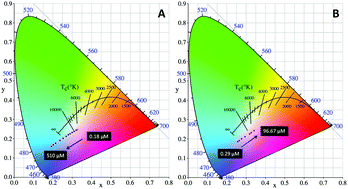One-step synthesis of a dual-emitting carbon dot-based ratiometric fluorescent probe for the visual assay of Pb2+ and PPi and development of a paper sensor†
Abstract
Herein, an easy and effective ratiometric fluorescent nanoprobe for the selective detection of Pb2+ and pyrophosphate (PPi) was developed based on label-free carbon dots (CDs). The CDs showed dual emission bands at 477 and 651 nm under a single-wavelength excitation (391 nm). Pb2+ and PPi were sequentially detected by the sensor with high reliability and accuracy via the exploitation of the fluorescence intensity ratio (F477/F651). The dual emission sensor exhibited high selectivity and excellent sensitivity for Pb2+ and PPi than for other analytes with detection limits as low as 0.055 μM and 0.089 μM, respectively. Moreover, the fluorescent CDs changed from pink to cyan and from cyan to pink and could be used as a fluorescent paper sensor for the visual detection of Pb2+ and PPi. To the best of our knowledge, this is the first report on the ratiometric fluorescence detection of Pb2+ and PPi by CDs; therefore, the as-synthesized CDs show great potential for application in the determination of Pb2+ and PPi in real samples.



 Please wait while we load your content...
Please wait while we load your content...